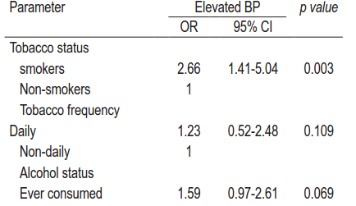Assessment of risk factors for hypertension in Dormaa municipality in Ghana using the World Health Organization STEPS approach
DOI:
https://doi.org/10.17532/jhsci.2018.281Keywords:
Hypertension, Risk Factors, STEPS ApproachAbstract
Introduction: Hypertension (HPT) is a significant public health challenge worldwide and is the single most important risk factor for cardiovascular disease. As life expectancy rates improve in Ghana and the prevalence of risk factors increase, the burden of non-communicable diseases such as HPT is also expected to increase. However, little is known about the specific factors that predispose of Ghanaians to a higher risk of HPT.
Methods: A cross-sectional study was conducted in the Dormaa Municipality in Ghana using the World Health Organization STEPwise approach to investigate risk factors for HPT. Study participants were recruited by probability proportional sampling technique. In all, 202 males and 198 females participated in this study.
Results: The mean age of the participants was 50.06 years (95% confidence interval [CI]: 48.46–51.66). In all, 40% of all participants in this study had elevated blood pressure (BP) (BP ≥140/90 mmHg). Further, the rate of isolated systolic HPT was 11.2% among the study population (12.9% in males and 9.6% in females). Risk factors as measured in the population were advancing age >45 years (odds ratio [OR] = 2.745, CI 1.20–6.30, p = 0.017), gender (44.6% males versus 35.4% females with elevated BP, male OR = 0.492, CI 0.28–0.86, p = 0.012), and tobacco use (OR = 2.66, CI 1.41–5.04, p = 0.003). Males reported higher mean portions of fruits (p = 0.036) and vegetable servings than females (p = 0.009) and spent more time each day on physical activities compared to females (p = 0.000).
Conclusion: The results of the present study provide useful data on HPT prevalence and associated risk factors in the Dormaa Municipality and the Brong-Ahafo Region of Ghana. To be able to control HPT in the municipality, health practitioners and policymakers should focus on these modifiable risk factors.
Downloads











